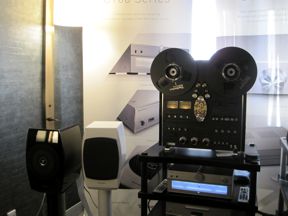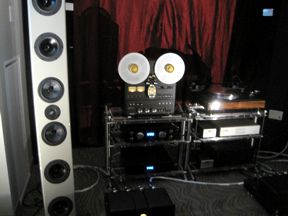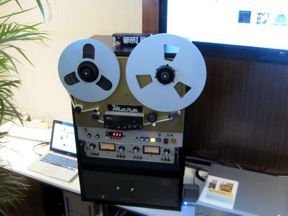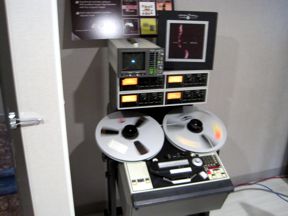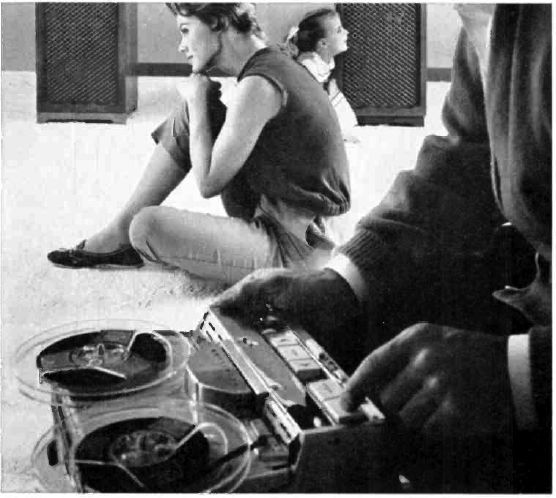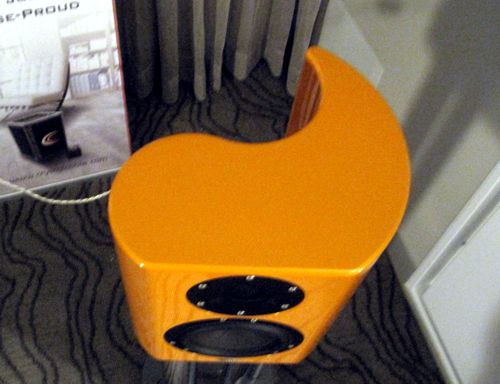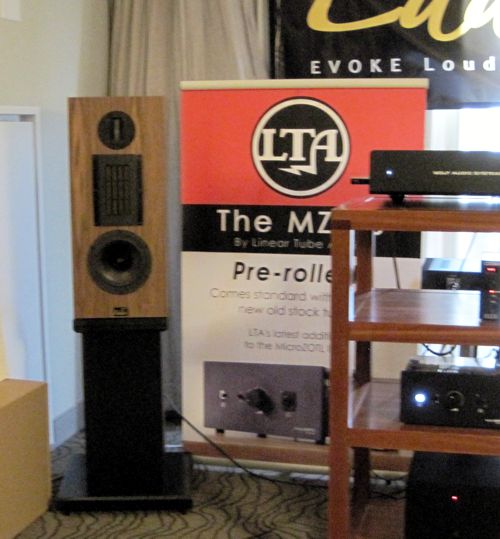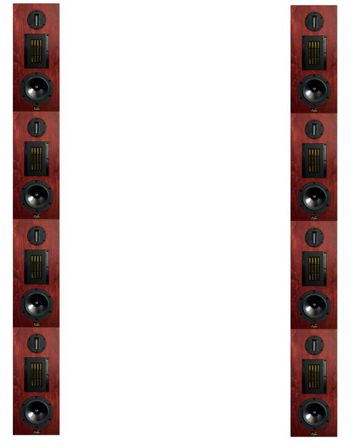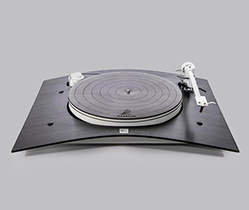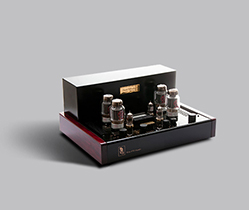| John Broskie's Guide to Tube Circuit Analysis & Design |
16 October 2016
RMAF 2016 In room number 1030, I sat down facing a pair of Avalon loudspeakers, which I had forgotten existed—which was a mistake, as they are excellent speakers. The largish room—a rarity at the event and chockfull with eager listeners—seemed to be without a skipper, as I could not figure out who was in charge. The sound emanated in the typical $100,000+ audio system fashion, good, in fact very good, but not 10 times better than the sound from $10,000 systems, let alone 100 times better than a $1,000 system. The chair was comfortable and I was in no hurry. Now the interesting part: the music source was switched from digital something to LP. Mercy, my ears exclaimed, this sounds much more—if you will indulge the pun—noteworthy. The music instantly lost its generic character and became unambiguously specific. Alive, naked sound, warts and all filled the room. Half the room got up and left. The old gentlemen sitting next to me remarked, "I don't get it, the sound improves dramatically and half the people leave." My response was, "Had an ensemble of musicians begun playing live music, would all of the audiophiles have left?" Strange. I then wondered if someone who had grown up listening exclusively to digital sound, could he then not enjoy analog sound, finding it strange-sounding? Imagine you grew up only having tasted bananas, cherries, and peaches from Slurpees and candy, would real bananas, cherries, and peaches taste good, or would you spit them out? A bit later, I mentioned what I had just experienced in room 1030 to my buddies, which included Lynn Olsen; he concurred in my dismay and he jogged my memory back to my breakfast in Davenport California back in the 1980s, which I had recounted back in post number 4.
By the way, while we were talking about this subject, the subject of the odd case of half of the audiophiles who fled the better LP sound, two capable musicians, a cellist and guitar player sat within 15 feet of us and began playing. Both cello and guitar were amplified, which caused moans in my group. Being contrary by nature, I pointed out that, under the right conditions, amplification can prove interesting, as when a small-wattage tube power amplifier is used, which softly clips, but allows the strings to ring on long after are ears could no longer hear the same string un-amplified, thereby creating a shimmering sustain effect. In addition, the guitar was an electric model, so the guitarist had no choice but to use an amplifier. One of the great things I discovered when we lived in Michigan, asides from the super nice folk and the gorgeous fall colors, was that I instantly felt as if I had lost 20 pounds, as everyone else seemed to have gained at least that many. Well, one of the great things about attending the RMAF is how, in spite of being 60, I feel so young there, as everyone else seems so much older. I made a joke about the seemingly lower attendance being due to the demise of several of the attendees from previous shows. Fortunately, my insensitive joke (are there in actual fact sensitive jokes, or is being funny—a thing that sensitivity would seem to preclude— just too essential a part of being a joke?) was misunderstood, as the assumption was that I was referring to the demise of audio companies, not audiophiles. Why do I always mention the hoary and wizened audiophiles at the RMAF? Simple: the future belongs to those who show up. If audio cannot arrest the attention of the young, it has no future—at least not a thriving and growing future. No doubt, there will always be audiophiles, just as there will always be matchbook collectors. But stop and think about it: When was the last time you saw a matchbook? (French readers are exempted from answering that question.) I am always on the outlook for father and son teams. This time, I was pleased to see a father and daughter pairing. How great is that! Not that she seemed overjoyed to be there, but then teens are a sullen lot. Still, my favorite overheard conversation arose a few RMAFs past, when a young boy said to his father as they exited a listening room, "I don't know, Dad, are you still sure that you make the best-sounding speakers?" I spoke to one wife who had been dragged to the event by her audiophile husband, who seemed bewildered by the expense and extravagance of it all. I repeated to her my quote from post number 278, which should one day make it into Bartlett's,
She nodded and told me that she now got it. Perhaps she did or she was just being nice.
Tape Players Everywhere
They do sounded amazing. Tape can sound so fine. In fact, I remember hearing amazing sound quality from lowly cassette tapes, albeit from expensive Sony and Nakamichi recorders. At the time I was convinced that horned-based jazz survived wow and flutter best, but that piano-based music didn't fare as well.
Well, two decades later, when DAT recorders came out, my buddy told me that he was ripping all his CDs to DAT, as he found the resulting sound much improved. The only way that such a situation could prove true was if the DAT held a better DAC and I-to-V stage, which I was quick to tell him. His reply was that both his CD player and DAT were made by the same company and that both held exactly the same DAC and I-to-V stage, which he knew from reviewing the repair schematics of both units. Well, if there is a difference there must be some underlying distinction between the two; perhaps, a better power supply in the DAT or perhaps.... Then, a decade later, some of my audiophile buddies told me that they were ripping their CD collections to black CD-ROMs, as they sounded better. Today, most of my friends use computer-based music server systems, either using Tidal or ripping and leaving their CDs stored in a box in their basements (I do all of the above). It seems as if the poor CD just can't get an even break.
Revenge of the Reasonable About 30 years ago, a friend of mine, who had earned an EE degree from a prestigious university, but worked as a salesman at a high-end audio salon (so great was his love of audio) told me an amazing story. A potential customer called and announced that he desired that the store assemble the finest-sounding stereo system possible, as his checkbook was just itching to spend a bunch of money. The customer arrived and loved the sound, but balked at the price, which at the time was a tad less than $30,000, as it was not high enough. His neighbor had spent closer to $40,000 and the customer would be embarrassed to own something less expensive. My friend explained that he had fulfilled the requirement of best-sounding, not the most expensive, and that the store could indeed sell him a more expensive system, but it would not sound as good. The distraught customer begged him to find a way to spend more money. The solution was found by a phone call to the loudspeaker manufacturer, who could apply an extra $15,000 worth of part upgrades. Sure, makes perfect sense, as einsteinium-filled hook-up wire does doesn't come cheap. And everyone was happy. What a great story to tell your kids, with the exception that the cost would have to be brought up to current pricing of the best-sounding system, say a tad less than $300,000. The RMAF staff deserve many pats on the back and a few free beers for acknowledging that the cult of Stupidly Expensive is ultimately bad for our audio hobby by devoting five rooms to entry-level systems, with each room presenting two systems (one LP-based and one digital based), one room devoted to systems selling for less than $500, another room two systems for less than $1,000, one room for less than $1,500, one for less than $2,500, and finally one for less than $5,000. I asked the fellow in the $500 room if there was a $100,000 room. His answer was all the other rooms at the show. Imagine trying to convince twenty-year-old that he shouldn't waste his $599 on a new iPad as with just a few hundred more he could buy a pair of entry-level speaker cables. Sure, makes perfect sense. But what will you say when he asks you what should he do with $800 speaker cables? Would you tell him that he could now attach his entry-level $20,000 speakers to his entry-level $10,000 amplifier. But what do you say when he tells you that he owns neither? Perhaps, you should have advise him to buy a $599 power cord instead. Well, the modern king of biggest bang per buck has to be Schiit. Jason Stoddard and Mike Moffat make the seemingly impossible possible. Think about it, surely the only way to make low-priced, high-quality audio gear is to make it somewhere other than the USA or Europe. Yet, all of Schiit products are made in the USA. How is that possible? Stoddard and Moffat possess tons of manufacturing knowhow and are super clever. But these two attributes are not enough. The essential missing psychological attribute is audacity, bold, insolent heedlessness of convention and historical precedent. They name their company Schiit; they spit on Stupidly Expensive; and they sell products that look and sound about three or four times better than their price tag would seem to imply. Pascal famously said, “I have only made this letter longer because I have not had the time to make it shorter." It is easy, all too easy, to make Stupidly Expensive audio gear (some it might be great-sounding); making intelligently-inexpensive great-sounding audio gear requires genius. Schiit unveiled at least three new products, the Saga, Freya, and Vidar. The first is a unity-gain passive/active buffer that uses relay to deliver 64 steps of precise attenuation, with the option of passive out or a 6SN7-based buffer out. In addition, the unit comes with a remote control. Now brace yourself, the cost of this audio wonder is only $349. Crazy cheap. Most high-end companies would charge you $349 for an optional remote control. As I wrote down the its list of features I felt the urge to mimic the infomercial , with phrases such as "How much would you expect to pay for just the relay-based stepped attenuator? $200, $300, $400... What if I were to tell you... If your order before midnight tonight, we will throw in the remote control unit, valued at $200..." The Freya is a balanced version that offers the output selection of either passive, JFET buffers, or 6SN7-based buffers. It accepts up two balanced inputs and three unbalanced (RCA-jack) inputs and offer either balanced or unbalanced outputs. Price: $699. The Vidar is a stereo/mono solid-state power amplifier, a class-AB amplifier not class-D. It puts out 100W into 8-ohm loads and 200W into 4-ohm loads—or 400W in bridged mono mode. Cost: $699. Staggeringly good deals.
The revenge of the Small Loudspeakers One example was the Arabesque Minissimo made by Crystal Cable. I walked into the room filled with prejudice. I was convinced that their unusual shape was only a gimmick, as I had seen the ad for their larger clear loudspeakers, whose shape and appearance I deemed to be just a gimmick.
Thus, I assumed the little speaker were just an attempt to borrow some of their bigger brother's sheen. So, with my prejudgment firmly in mind, I sat down for some listening. Dang, they sounded great. Amazing bass, wonderful mids, non-annoying highs, with splendid imaging—I was wrong. Still, I would never buy these loudspeakers, as I would prefer to spend $12,995 on something less recklessly expensive. On the other hand, if your bank account overflows and you regularly leave more than $12,995 in tips each year, give them a listen, as they might be perfect for one of your guest cottages or your beach home. One lesson we can learn from the Arabesque Minissimo is that the loudspeaker enclosure counts, as its shape alters the frequency response. This was known back in the 1950s (I remember reading an excellent article in an old issue of Audio Engineering from that era that showed the quite dramatic effects that enclosure shape had on speaker frequency flatness). Another good-sounding loudspeaker was the Sonner Audio Allegro Unum. This attractive two-way impressed me mightily. But as I listened to it, I wondered how much better it would sound if paired with high-quality tube gear. One small loudspeaker that surprised me was the Ono Audio Paka, which looks like a two-way, but is actually a three-way design.
This obviously inspired by Siegfried Linkwitz loudspeaker delivers a much bigger sound than you might imagine from its small size. The design is worth examining in detail and I highly recommend that you visit the Ona Audio website to read the technical explanation for the design choices made. I also highly recommend that you give them a serous listen. Your ears will thank you, as will your wallet, as they cost less than $3,000 the pair. Another cost-effective overachieving smallish loudspeaker was the Evoke Loudspeaker's Eddie.
They are not mini monitors, as they stand 23.75 inches tall and are 10.25 inches wide. Sitting atop the large speaker stands, however, they didn't seem that small. These speakers sport a ribbon/planar midrange and tweeter, along with a 7 inch woofer. They are 4-ohm designs and deliver 89dB @ 1w @ 1 meter. The highs give the impression that they go on forever and yet not sound shrill. The imaging was focused. I wondered what they would sound like after a few months of serious playing; perhaps a tad warmer, due to mechanical loosening of the woofer's surround. No doubt that the Eddie had the advantage of being paired with Linear Tube Audio (LTA) gear. LTA makes reasonbably-priced tube equipment designed by David Berning: their products already come pre-tube-rolled, as they come with great-sounding NOS tubes. Their productline may appear retro, but they hold cutting-edge tube designs. Which brings me back to the bass, which I thought sounded a bit dry. Berning's ZOTL design is famous for not making big, fat, sloppy bass, but rather tight, controlled bass, as it does not use an output transformer. In other words, paired up with a typical transformer-coupled tube amplifier, the Eddie speakers would probably warm up quite a bit. The Eddie's cost was nearly just a fourth as much as the Arabesque Minissimo, costing only $3495 the pair.
Which raises an interesting thought experiment. Say you did buy four pairs of the Evoke Eddie speakers and you made two stacks of four speakers, which would just fit with an 8-foot ceiling. Now, say that only one pair faced you, with two pair firing at the adjacent walls, and one pair firing backwards. My guess is that the sound would be both effortless and authoritative, with amazing imaging and with a +6dB increase in efficiency. What prompts me to make this guess is that I once heard such a setup with eight little BBC mini-monitors.
The Death of Class-AB Really? Does this apply only to current-production amplifiers or do old Audio Research, Conrad Johnson, Dynaco, Futterman, Harman Kardon, Heathkit, Marantz, McIntosh, and Quad tube-based power amplifiers also get the class-A upgrade? If not, why not? If so, why? And just as importantly, why didn't they advertise their amplifiers as being class-A to begin with, rather than the humbler class-AB? We have all heard of university grade inflation, where no student is left behind getting a mere A- (which would seem to imply that the student wasn't as smart as Aristotle or Darwin or Einstein, which we all know to be impossible, as today's students own laptops), where a solid 4.0 grade average is deemed to be a bit low, as both teachers and students are so much smarter today, and as we have long ago shattered the 4.0 ceiling. Well, when I moved to Colorado, I had to get a new drivers license and I had to go through the DMV ordeal. I had filled out my forms, passed my test and I stood before the dour DMV employee who was reviewing my paperwork before she would snap my picture. Everything was going well until she got to my height, which I had put down as 6'2," which prompted her to blurt out, "Six two, oh come on now." I pleaded, "Well, I used to be six two; but I guess you lose some height as you age." She just shook her head and erased what I put down and filled in new numbers. I was not about to argue with her, as I was standing in front a background that held height measurements ruled out, starting at four feet and ending at seven feet. After she photographed me and gave me my forms, I saw that I was now six three. Amazing. How cool is that. If I can live another twenty years, I might be six five. No doubt that so many men lie about their height that their exaggerations are the new reality. (It is said that in Los Angeles, no man is five eleven.) Returning to the world of audio, which is located somewhere between Disneyland and hard reality, I want you to pause a moment and reflect that the maximum theoretical efficiency of a class-A amplifier, whether push-pull or single-ended, is 50%, which would assume perfect devices; in other words, a triode with an rp of zero ohms. Thus, a perfect 100W class-A push-pull amplifier would dissipate 200W at idle, as efficiency equals 100% x Pout/Pidle. Perhaps that does not sound too extreme, but do not forget that 200W applies only to the two output devices and does not include the power required for powering the heaters and driver and input circuits or the power required for indicator lights or fans or the transformer core or rectifier losses—just the output stage. In other words, even if a 100W power amplifier dissipates 200W at idle, we could never conclude that the amplifier operates in class-A; indeed, as the amplifier hold tubes, we could be certain that it doesn't. Thus, if two tubes are used, say two KT88s, each plate must dissipate 100W at idle. The only problem is that the KT88 exhibits a 42W plate dissipation limit. Running this tube at 238% of its plate dissipation is not a good idea, just as running your car's engine at 2.38 times its redline RPM. In other words, harsh reality dictates that at least six KT88 would be needed to produce 100W, each dissipating 33.3W, while bit more reality would demand eight KT88 in a class-A push-pull amplifier. Moreover, this assumes pentode and ultra-linear operation, as triode-connected KT88 tubes yield only half as much power. How did we go off the rails of simple math and common sense? Interestingly enough, at this most recent RMAF, I discovered that I am the kinder and gentler type. Who knew? I certainly didn't. Whenever some egregious claim was made for some audio product, such as interconnects that allowed electrons to travel faster than the speed of light, thereby making the cable sound fast, I concluded that the cable manufacturer was misinformed and misguided, but sincere in his insane beliefs. My comrades in ears were not so generous, perceiving only malice and fraudulence. As they say in Hollywood, "The secret of success is sincerity. Once you can fake that you've got it made." My kind and gentle theory is that many have confused cathode-bias with class-A and grid-bias with class-AB. Alas, transistor power amplifiers do not hold any cathodes, so they do not get the free upgrade from coach to first-class. Sure, it's stupid, but it's not evil. Others claim in lawyer-like fashion that the dripping output tubes they used are so gooey that they never really cutoff, like some old drooling dog, some trickle of current persists. Now, dear reader, pause and reflect: Just why do we care if a power amplifier is class-A or any other class? The answer is that class-A amplifiers, which all single-ended amplifier are by necessity but which only a few push-pull amplifiers are by design, exhibit a constant transconductance. Why would that prove advantageous?
Here is an analogy that might make the point. Imagine that you visit a friend and he wants to regale your eyes with his huge home-theater screen, which spans the length of his living-room wall. But unlike most screens, his does not unroll; instead, it is folded away when not in use. The only problem is that when unfurled, the fold marks are clearly visible, making the projected panorama marred by unsightly creases. So, in spite of its imposing size, you actually prefer seeing movies projected on your smaller, but flat screen. So, too, it is with output stages, a constant transconductance results in a constant-output impedance and thus no unsightly sonic creases. Drippy output tubes only add more wrinkles.
Best Sound at the RMAF
Before describing what I heard, I must reveal a secret, particularly to you millennials. If you enter an audio salon or attended an audio show or just visit a fellow audiophile's home, what you most likely to hear is thud, thud, thunk, twang, sizzle, whack, whack, ping, bang, pluck, zing: percussion combined with thumping bass and piercing highs. In one of the rooms of the RMAF, I actually heard a recording of gunshots. Although each genre of music offers selected pieces that qualify, a genre like the blues that relies heavily on plucked instruments and drums and only a few members in the band is most likely to be heard. Surely this makes sense, no? Aren't percussive twangs and bangs the most difficult to reproduce? No. Indeed, no. Sadly, no. The most difficult musical sounds to reproduce are massed voices and violins, smooth intricate sheets of sound, not prickly, gagged, popcorn-popping sounds. Thus, the real reason you seldom hear symphonic or choir music played in audio demos is not just their decreasing popularity, but because it is the most difficult music to pull off successfully. In the Margules room, the achievement was staggering. Before my ears, a large orchestra triumphantly performed. No discontinuities, no rents or gaps, the large canvas of sonic presentation unfurled across the back of the room. This is rare, so rare that I would assume it impossible, if I hadn't actually heard it a few lucky times in my life. In contrast, loving to hear the blues in your house is easy, as is loving to hear jazz, bluegrass, alternative, and rock 'noise roll music; indeed, the Rolling Stones sound great in my car. I would love to take the Margules system home, so I could love hearing symphonic or chorale music. Of course, Margules equipment can just as easily play the blues or the Rolling Stones, just as easily as a high-wire trapeze artist can walk on the sidewalk, but is the high-wire act that thrills us. What makes Margules's accomplishment all the greater is the wonderfully reasonable cost of his products. The high-end-audio practice of stupidly expensive does not apply to Margules line. For example, the Margules stunningly attractive and excellent sounding turntable, the TT-1, cost less than $3,000 and includes the tonearm. Their U280sc power amplifier sounds and looks like it should cost easily twice as much as its actual below $4,000 price tag. Okay, how is this possible? Two answers explain all. First, Margules is located in Mexico City, Mexico and the dollar is quite strong relative to the peso right now. If Margules moved to France or Switzerland, his products would look and sound exactly the same, but cost three or four times more. Second, and more importantly, Julian Margules is super smart and capable, which do not always go together, but in his case they do to a high degree. I have discovered that many, if not most other high-end tube-audio-gear manufacturers are—how do I put this this gently—less smart and less capable. Many just copy 40-year-old designs. True those designs were often created long ago by smart capable engineers; but those very same engineers, if they were alive today, would not stick to those old designs, but would create new designs, designs much closer to what Julian Margules is creating today. Do yourself a favor and check out his offerings. Remember, buy North American, be North American.
Special Thanks
//JRB
User Guides for GlassWare Software Since I am still getting e-mail asking how to buy these GlassWare software programs:
For those of you who still have old computers running Windows XP (32-bit) or any other Windows 32-bit OS, I have setup the download availability of my old old standards: Tube CAD, SE Amp CAD, and Audio Gadgets. The downloads are at the GlassWare-Yahoo store and the price is only $9.95 for each program. http://glass-ware.stores.yahoo.net/adsoffromgla.html So many have asked that I had to do it. WARNING: THESE THREE PROGRAMS WILL NOT RUN UNDER VISTA 64-Bit or WINDOWS 7 & 8 or any other 64-bit OS. One day, I do plan on remaking all of these programs into 64-bit versions, but it will be a huge ordeal, as programming requires vast chunks of noise-free time, something very rare with children running about. Ideally, I would love to come out with versions that run on iPads and Android-OS tablets.
//JRB |
Kit User Guide PDFs
And
High-quality, double-sided, extra thick, 2-oz traces, plated-through holes, dual sets of resistor pads and pads for two coupling capacitors. Stereo and mono, octal and 9-pin printed circuit boards available.
Designed by John Broskie & Made in USA Aikido PCBs for as little as $24 http://glass-ware.stores.yahoo.net/
The Tube CAD Journal's first companion program, TCJ Filter Design lets you design a filter or crossover (passive, OpAmp or tube) without having to check out thick textbooks from the library and without having to breakout the scientific calculator. This program's goal is to provide a quick and easy display not only of the frequency response, but also of the resistor and capacitor values for a passive and active filters and crossovers. TCJ Filter Design is easy to use, but not lightweight, holding over 60 different filter topologies and up to four filter alignments: While the program's main concern is active filters, solid-state and tube, it also does passive filters. In fact, it can be used to calculate passive crossovers for use with speakers by entering 8 ohms as the terminating resistance. Click on the image below to see the full screen capture. Tube crossovers are a major part of this program; both buffered and un-buffered tube based filters along with mono-polar and bipolar power supply topologies are covered. Available on a CD-ROM and a downloadable version (4 Megabytes). |
||
| www.tubecad.com Copyright © 1999-2016 GlassWare All Rights Reserved |


